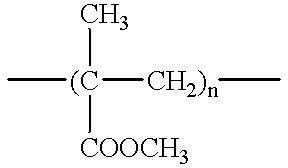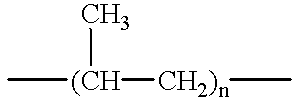Method of device having biostable elastomeric polymers having quaternary carbons
a technology of elastomeric polymers and quaternary carbons, which is applied in the field of devices having biostable elastomeric polymers having quaternary carbons, can solve the problems of inability to tolerate type of behaviour, polymers that are not stable in the physiological environment tend to crack and degrade, and many otherwise highly desirable materials exhibit serious deficiency, so as to prevent cracking, crazing or degradation.
- Summary
- Abstract
- Description
- Claims
- Application Information
AI Technical Summary
Benefits of technology
Problems solved by technology
Method used
Image
Examples
example 2
A linear triblock copolymer resin of styrene-PIB-styrene of 34 wt % styrene according to the present invention was prepared. This copolymer resin was melt extruded from a cylinder through a heated orifice with a piston under pressure to form a continuous monofilament of the copolymer 1 mm in diameter. The monofilament was cut into two inch long samples. Some of the samples were sterilized in ethylene oxide, and some of the sterilized samples were implanted subcutaneously in the back of dogs for two and four weeks, respectively. Following explant of the samples which had been implanted, three of each of the following samples were tested under load to determine their breaking strength on an Instron Tensile Testing Machine, Model No. 1011:
A--control, unsterilized, and not implanted.
B--control, sterilized but not implanted.
C--sterilized, implanted and explanted after 2 weeks.
D--sterilized, implanted and explanted after 4 weeks.
The results of the load tests are shown in FIG. 1. The "T" e...
example 3
The linear triblock polymer of the invention and as described in Example 2 was formed into a porous non-woven membrane. To do so, the triblock polymer was dissolved in the amount of 6% solids in tetrahydrofuran. This solution was sprayed with an air brush onto a rotating mandrel. The environment was controlled during spraying so that the tetrahydrofuran evaporated between the sprayer and the mandrel and so that a porous mat was formed on the rotating mandrel. These samples were then fully dried in air and removed from the mandrel.
A known polyether urethane was also formed into a non-woven membrane. The polyether urethane was of the kind which is regularly employed as implantable pacemaker leads and was Pellethane 2363-80A from Dow Chemical, Midland, Mich. Pellets of the polyether urethane were dissolved in the amount of 45% solids in dimethyl acetamide while agitating and heating. This solution was pumped through a spinneret with 30 orifices on a shuttle that reciprocated back and f...
PUM
| Property | Measurement | Unit |
|---|---|---|
| time | aaaaa | aaaaa |
| molecular weight | aaaaa | aaaaa |
| molecular weight | aaaaa | aaaaa |
Abstract
Description
Claims
Application Information
 Login to View More
Login to View More - R&D
- Intellectual Property
- Life Sciences
- Materials
- Tech Scout
- Unparalleled Data Quality
- Higher Quality Content
- 60% Fewer Hallucinations
Browse by: Latest US Patents, China's latest patents, Technical Efficacy Thesaurus, Application Domain, Technology Topic, Popular Technical Reports.
© 2025 PatSnap. All rights reserved.Legal|Privacy policy|Modern Slavery Act Transparency Statement|Sitemap|About US| Contact US: help@patsnap.com



